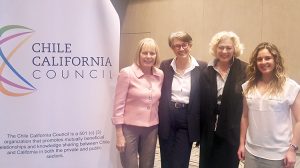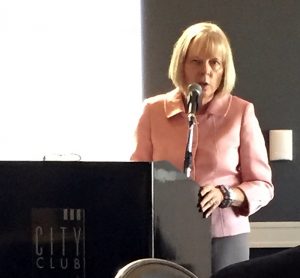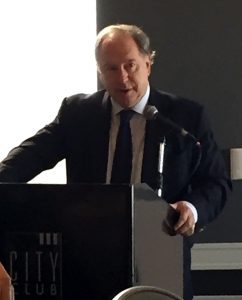
Aspects of the growing trade and investment relationship between Chile and the United States, as well as California, were discussion topics at the annual Chile-California Council meeting last week.
The April 20–21 agenda included presentations by the U.S. ambassador to Chile and the Chilean ambassador to the United States, plus panel discussions on emergency management and entertainment.
Growing Partnership
U.S. Ambassador to Chile Carol Perez discussed the growing trade and investment between Chile and the United States; the partnerships being created in numerous areas, including disaster assistance and environmental issues; the expansion of academic and scientific exchanges; and the security and protection of Americans in Chile.

Approximately 50,000 Americans live in Chile, and about 240,000 Americans visited Chile last year. Americans generally feel safe and secure traveling in Chile.
Ambassador Perez went on to say that the U.S.-Chile Free Trade Agreement is the cornerstone of the U.S.-Chile partnership. Jobs are not leaving the United States as a result of the agreement, she stated; in fact, the United States has a trade surplus with Chile.
The Ambassador is making a big push for involvement in the SelectUSA summit to be held in June with an emphasis on investment.
In addition to devoting half of her time to trade and investment issues, Ambassador Perez said she also is focused on supporting women microentrepreneurs and promoting English language among the Chilean population.
Less than 5% of Chileans speak English, which is the lowest figure in the hemisphere. In particular, there is an emphasis to educate at the university level, so academic works can be published in English.
Ambassador Perez concluded by saying that Chile is a model country in the hemisphere, both in developing democracy and anti-corruption efforts.
Value for Chileans

Chilean Ambassador to the U.S. Gabriel Valdés explained why Chileans value the Chile-California Council. Regardless of changes in administrations, both in the United States in 2016 and with the upcoming 2017 Chilean presidential election, the relationship is built on friendship, cooperation and stability which transcends politics or social movements, Ambassador Valdés said.
Chile still believes in the principles of the Trans-Pacific Partnership, the Ambassador commented. He pointed out that the Chilean Navy recently participated with the U.S. Navy in peace-keeping exercises.
Ambassador Valdés concluded saying that relationship between our civil societies in the areas of business, academics, the arts and culture, and science are most important.
Emergency Management
A session on emergency management collaboration between Chile and California was moderated by Tracy Katelman of ForEverGreen Forestry. Panelists were:
- Mark Ghilarducci, director of the California Office of Emergency Services (CalOES);
- Ken Pimlott, director of the California Department of Forestry and Fire Protection (CAL FIRE);
- Aaron Cavieres, director of CONAF, The National Forestry Corporation, a private law entity moving to be a public agency under the Chilean Ministry of Agriculture, whose main task is to manage the forestry policy of Chile; and
- Ricardo Toro, director of Chile’s ONEMI, the National Emergency Office of the Ministry of Interior and Public Security.

ONEMI Director Toro discussed how Chile faces emergencies from the national to the municipal levels, the new reality of high exposure to multi hazards, the continuation of improvement in Chile’s emergency system, especially its early warning methods, and the office’s relationship and Memorandums of Understanding (MOUs) with California.
Since 2010, Chile has had more emergencies and fewer victims due to building on capacities and improved systems.
CONAF Director Cavieres discussed the “sixth generation” fire which took place in January to February 2017 for 18 days, burning nearly 3 million acres, affecting 2,288 homes with 11 casualties and a cost of US $32,934,225. This firestorm followed a prolonged drought and actually changed the local weather.
CalOES Director Ghilarducci spoke of the standardized emergency system California has built around laws with a structure starting at the local level. The California emergency system is designed around supporting the local emergency area, with the help of the regional, and last the state level.
CAL FIRE Director Pimlott described how the 100 million acres of California land are one-third under federal jurisdiction, one-third under local jurisdictions with the assistance of approximately 1,000 fire departments ranging from Class 1 to volunteer fire departments, and one-third under the jurisdiction of the state/CAL FIRE, which are “trust lands” or “private watershed” lands.
In the state one-third, there are about 75,000 homes that are assessed fees to assist with fire prevention. Unfortunately, 95% of the fires in California are started by people.
The session concluded with the signing of an MOU between Chile and California, bringing closer the two territories in their efforts to tackle shared emergency concerns, including earthquakes, fires, mudslides and tsunamis.
Entertainment

Marketing professional Francisco Letelier moderated a panel on the entertainment industry—shared challenges and opportunities for Chile and California. The speakers were Lorenzo Soria, president of the Hollywood Foreign Press Association; Gary Shapiro, an American producer; Loreto Caro, a Chilean director; Pedro Pablo Cabrera, representing Shoot in Chile; and Juan de Dios Larraín, a Chilean producer.
Shapiro began by summarizing the importance of the entertainment industry to the global economy. He commented that 70% of entertainment business revenue comes from outside the United States (especially growing in China and Russia) and only 30% from within the U.S. This is the reverse of 10 years ago.
Specialized lower-budget films are becoming more popular in the United States. A recent example is La La Land, which has made $700 million around the world with an initial investment of less than $20 million.
Caro focused on the need for education and training in film making in Chile. Students still need to travel abroad to pursue graduate-level studies. There is also a need for Chile to work on intellectual property protection for creative works.
Soria discussed the major challenges as constantly evolving technology changes the entertainment landscape. An example is the new interest in binge watching. Soria also reported that the Golden Globes had 400 English titles (films ) to review this year compared to 150 just five years ago.
De Dios Larraín suggested that Chile should develop incentives to attract filmmakers and create a Chilean brand to be recognized in Hollywood and internationally. Although Spanish language films have not brought Latin America together, de Dios Larraín said, perhaps new shows for television will.
Cabrera concluded by saying Chileans need to learn to speak more English and create a marketing plan for shooting films in Chile.
Best Practices
The meeting also gave an opportunity for discussion and sharing of best practices between the California Chamber of Commerce and the American Chamber of Commerce in Chile (AmCham Chile) representatives.
An MOU between AmCham Chile and the CalChamber, together with the Los Angeles Area Chamber of Commerce, was signed in Santiago, Chile, on September 28, 2009 to encourage and promote trade and investment between the chambers.
Chile-California Council
The Chile-California Council is an international nonprofit organization that promotes mutually beneficial relationships and knowledge sharing between Chile and California in both the private and public sectors. See http://www.calchamber.com/Chile and the Chile-California Council website, https://chile-california.org/.
Working in relational public diplomacy, the council unites advocates from both the public and private realms to support bilateral cooperation among individuals, groups, organizations, corporations, world class universities, and governmental agencies to promote scientific research, entrepreneurship, social innovation and public leadership. The CalChamber has been a member of the council since its inception.
On a daily basis, the Chile-California Council identifies opportunities for collaboration, facilitates strategic connections, and incubates ideas in a wide range of areas, particularly in education, environment, science, technology, and innovation. By promoting the value and the opportunities of long-term collaboration between Chilean and Californian individuals, organizations, businesses, and governmental institutions, the Chile-California Council seeks to contribute to the betterment of both territories.
Statistics
Since the U.S.-Chile Free Trade Agreement (FTA) was implemented on January 1, 2004, bilateral trade between Chile and the United States has nearly quadrupled and both trade and investment opportunities abound. Upon entry into force of the U.S.-Chile Free Trade Agreement (FTA) in 2004, 80% of U.S. consumer and industrial goods exports to Chile immediately became duty free. Tariffs on the remaining products were phased out with 100% of products duty free in 2015.
Two-way trade in goods between the United States and Chile was approximately $21.74 billion in 2016. According to the U.S. Department of Commerce, U.S. goods exports to Chile increased 474% in the 13 years since the FTA went into effect, from $2.7 billion in 2003 to $12.9 billion in 2016. Exports to Chile of transportation equipment, petroleum, chemicals, and computer and electronic products from the United States have experienced a marked increase since 2003.
Chile is the United States’ 23rd largest export destination with $12.9 billion in exports in 2016. Top imports from Chile to the United States include agricultural products, primary metal manufacturing, other animals, and wood products. Top exports from the United States to Chile include transportation equipment, petroleum and coal products, machinery, and chemicals. Nearly 12,000 U.S. firms export approximately 5,000 products to Chile. More than 2,000 Chilean firms exported as many different products to the United States. U.S. foreign direct investment (FDI) in Chile totaled $27.3 billion in 2015, and Chilean FDI into the U.S. totaled $2 billion in the same year.
According to AmCham Chile, more than 300 U.S. companies have investments in Chile, with over 40 of them using Chile as a platform for services in the region. Chilean affiliates of U.S. direct investors are estimated to employ more than 58,500 people and their value added contributed 3.2% to Chile’s gross domestic product (GDP).
Chile is nearly twice the size of California and home to nearly 18 million people and renowned copper mines. In 2003, the Chilean economy began to recover after a 1999 slump, reaching a 3.3% growth in real GDP. According to the most recent figures, Chile has a GDP of $240.79 billion. Since 1990, there has been more than $50 billion in FDI in Chile. Chile has the most stable and fastest-growing economy in the region, which puts it in the best position to promote democracy and political freedom. Chile has 59 bilateral or regional trade agreements in effect, more FTAs than any other country. Chile is the only Latin American country that is a member of the Organisation for Economic Co-operation and Development (OECD).
In 2016, Chile was California’s 26th largest export destination with $1.3 billion in exports. Top exports from California to Chile include petroleum and coal products, transportation equipment, computer and electronic products, and machinery. Top imports from Chile to California include agricultural products, food manufacturers, wood products, and beverages and tobacco products.
Staff Contact: Susanne T. Stirling


